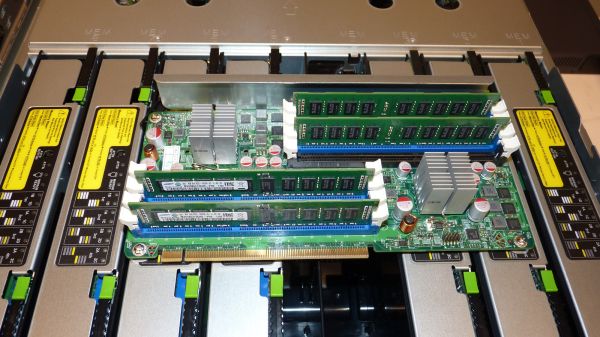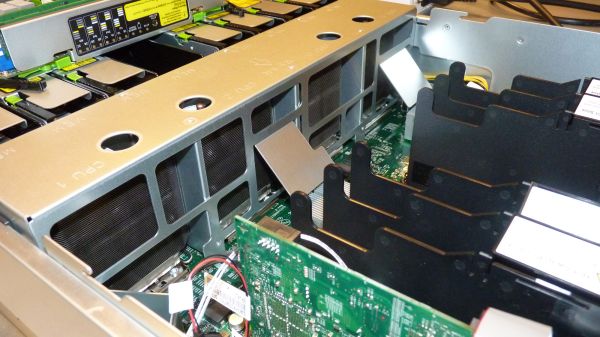Westmere-EX: Intel Improves their Xeon Flagship
by Johan De Gelas on April 6, 2011 2:39 PM EST- Posted in
- IT Computing
- Intel
- Nehalem EX
- Xeon
- Cloud Computing
- Westmere-EX
Our Test Server
We are currently testing the new Intel QSSC-S4R server. Intel claims that even though the TDP of the best quad-socket Xeons is still 130W, the total platform power consumption is quite a bit lower. We are definitely interested to see if this is the case.
The test system comes with eight memory daughterboards, each with two memory buffers and four DIMMs per memory buffer. With 8GB DIMMs, you can easily fit 512GB of memory into the system.
The four CPUs are cooled by massive 3U high heatsinks.
We are performing some virtualization benchmarking (VMware vSphere 4.1 update 1) as we speak. SQL Server 2008 and power numbers will be added too. At a later date we should be able to give some Linux KVM benchmarking numbers. For now, we don't have any results to report, but stay tuned....













32 Comments
View All Comments
Speed3mon - Friday, April 8, 2011 - link
Gay!agreenbhm - Wednesday, April 6, 2011 - link
That thing is weak!Ushio01 - Wednesday, April 6, 2011 - link
The E3 Sandy bridge xeons have hyper threading so should be 4/8 in the table.JarredWalton - Wednesday, April 6, 2011 - link
Apparently the PDF is incorrect... they only list 4 (or 2), but I'll update the table.(http://newsroom.intel.com/servlet/JiveServlet/down...
dcollins - Wednesday, April 6, 2011 - link
What is purpose of such high-end, high price CPUs? I am honestly curious, not being sarcastic.It seems to me that buying more cheaper servers would give better performance for the money. Anyone care to enlighten me?
Arnulf - Wednesday, April 6, 2011 - link
Lower combined power usage ?Lower heat output and fewer related heat management issues ?
Smaller volume ?
Easier management (only one system to maintain rather than a number of separate systems) ?
I'm sure one could think of more potential upsides, but there are also potential downsides (such as "single dead CPU = dead server").
cdillon - Wednesday, April 6, 2011 - link
There are still some applications that haven't been designed to scale to multiple servers, so one large monolithic server is required to scale that application performance up.When it comes to consolidation virtualization, which easily scales to multiple servers, I think multiple 2-socket servers hit the price/performance "sweet spot" and 4-socket servers are less cost-effective. 8+ socket consolidation virtualization hosts are an irresponsible waste of money and anybody using 8-socket servers in that particular situation are simply doing it to appear impressive and not considering price/performance, or have a simple-minded "bigger is better" mentality.
Concillian - Wednesday, April 6, 2011 - link
Sooo... like... all upper management then?
Iketh - Wednesday, April 6, 2011 - link
My friend works at a retro TV station here in the US. All they do is read shows from magnetic tapes and copies them bit-by-bit into huge multi-GB files on harddrives. They have dual quad-core systems running each instance. The cpus hover at 2-3% usage, with cooling fans in each system spinning at 20k rpms so that it sounds like a wind tunnel when you walk into the room. Absolutely sickens me. And the CEO is in the "hall-of-fame" at the college he graduated from...yuhong - Wednesday, April 6, 2011 - link
Not all virtualization software even support 8-socket servers anyway, for example Hyper-V is limited to 64 logical processors.